
James Mallory
Professor
Learning Consortium
National Technical Institute for the Deaf
585-475-2865
Office Location
James Mallory
Professor
Learning Consortium
National Technical Institute for the Deaf
Education
AAS, Kent State University; BS, MS, Rochester Institute of Technology
Select Scholarship
Published Conference Proceedings
Mallory, James R. "Empowering Special Needs STEM Students Through Unique Generative AI Tools: A Path to Inclusive Learning." Proceedings of the Empowering Special Needs STEM Students Through Unique Generative AI Tools: A Path to Inclusive Learning. Ed. Dr. Don Himes. Las Vegas, Nevada: LearnTechLib The Learning and Technology Library, 2024. Web.
Mallory, James and Edmund Lucas. "Teaching IoT in Both Physical and Virtual Environments." Proceedings of the 2023 ASEE Annual Conference & Exposition, Baltimore, Md. June 2023. Ed. Diana Bairaktarova. Baltimore, Md: American Society of Engineering Education, 2023. Web.
Mallory, James R. and Linda Bryant. "HyFlex Teaching for DHH Learners: Experiences and Best Practices." Proceedings of the Southeast Regional Institute on Deafness. Ed. Mark Sommer. Charlotte, NC: Southeast Regional Institute on Deafness, 2023. Web.
Invited Article/Publication
Mallory, James R. and Anderson Lee. "Getting Non Technical DHH Adults in the Technical Workforce." CCWT Spring Webinar Series Getting Non Technical DHH Adults in the Technical Workforce. (2024). Web.
Invited Paper
Mallory, James R. and Linda M. Bryant. "Enhancing Learning Outcomes for Students with Diverse Learning Needs in a HyFlex Environment: Insights from CompTIA A+ Certification Preparation." LearnTechLib. (2025). Web.
Bryant, Linda M. and James R. Mallory. "Establishing a PearsonVUE Test Center for D/DB/HH: Why, How, Why Bother." Southeast Regional Institute on Deafness Conference Proceedings. (2023). Web.
Mallory, James R. and Edmund Lucas. "How Raspberry Pi Technology Can Enhance Students’ Learning Opportunities in Technology." nyseta.org. (2018). Web.
Journal Paper
Mallory, James R., et al. "Deaf and Hard of Hearing Online Learners in Postsecondary Education: Part 1-Student Perspectives Pre COVID-19." Journal of Education Online (JEO) 20. 2, Special Edition (2023): ORCID iD: 0000-0002-6503-2041. Web.
Starin, Kristen, Amanda Picioli, and James Robert Mallory. "Using Accessibility Technology to Engage Your Students and Enhance Communication in Your Technical Classroom." American Society for Engineering Education. (2022): 21-23. Web.
Mallory, James, et al. "Personal Perspectives on Using Automatic Speech Recognition to Facilitate Communication between Deaf Students and Hearing Customers." ACM ASSETS 2017 Conference Proceedings ASSETS’17, October 29-November 1, 2017, Baltimore, MD, USA. ACM ISBN 978-1-4503-4926-0/17/10 (2017): 1-4. Web.
Invited Keynote/Presentation
Mallory, James R. and M. Billowus. "Teaching Technology in the Virtual World of Second Life." 17th Annual SLOAN Consortium on Asynchronous Learning Networks. SOAN Consortium. Orlando, Florida. 15 Oct. 2014. Conference Presentation.
Mallory, James R., et al. "Preferences for Deaf and HH Learners in Online Classes." Association for Computing Machinery (ACM) Special Interest Group on Accessible Computing (SIGACCESS). RIT. Rochester, New York. 21 Oct. 2014. Conference Presentation.
Mallory, James R. and Vicki Robinson. "Using Virtual World of Access Technology to Teach Physics and Computer Hardware to Deaf and HH Students." Association for Computing Machinery (ACM) Special Interest Group on Accessible Computing (SIGACCESS). Rochester Institute of Technology. Rochester, New York. 21 Oct. 2014. Conference Presentation.
Published Article
Mallory, James. “Using Second Life to Enhance Student Learning ofTechnical Concepts.” Exploring Instructional and Access Technologies. An International Symposium in Technology and Deaf Education, NTID at RIT. Rochester, NY. 23 June 2010. Web. Print. *
Formal Presentation
Mallory, James, and Vicki Robinson. “Using Second Lifeto Enhance Student Learning of TechnicalConcepts.” American Society for Engineering Educators. Rochester, NY. 27 Mar. 2010. Formal Presentation.
Long, Gary, and James Mallory. “Deaf and Hard-of-Hearing Online Learners.” Exploring Instructional and Access Technologies. An International Symposium in Technology and DeafEducation, 22 June 2010, NTID at RIT. Rochester, NY. Presentation.
Mallory, James, and Joseph Stanislow. “Using Virtual World of Second Life to Teach Technology.” 21st International Congress of the Education of the Deaf. Vancouver, B.C. 19 July 2010. Presentation.
Currently Teaching
NACT-160
Networking Essentials
3 Credits
This course introduces students to the basics of user security on their computers as well as the basics of computer networking. Students will learn the importance of user security and some of the tools and procedures needed to protect and secure their information, computers and networks against attack. Basic concepts and terminology of wired and wireless networking including networking hardware, media, communication technologies and protocols, and network management will be covered. Lab activities will develop skills in installing, configuring, managing, and troubleshooting a basic network.
NACT-200
Help Desk Support
3 Credits
This course focuses on key information and proficiencies needed to support users, including troubleshooting, problem solving, successful communication, determining a client's needs, and using appropriate people skills.
NACT-295
ACT Technical Capstone
3 Credits
This course provides an opportunity for students to work on technical projects that integrate the skills they have developed in earlier Applied Computer Technology courses. Students will work both independently and in teams to solve "real world" networking and computer support problems in a professional manner.
In the News
-
January 31, 2022
![person wearing a hearing aid and a mask working on a laptop.]()
RIT/NTID offers boot camp-style IT training, certification for deaf, hard-of-hearing learners
The DeafTEC Resource Center at NTID is partnering with information technology industry certification leader CompTIA to provide a full-time, 10-week hands-on training course at no cost for deaf and hard-of-hearing adult learners.









